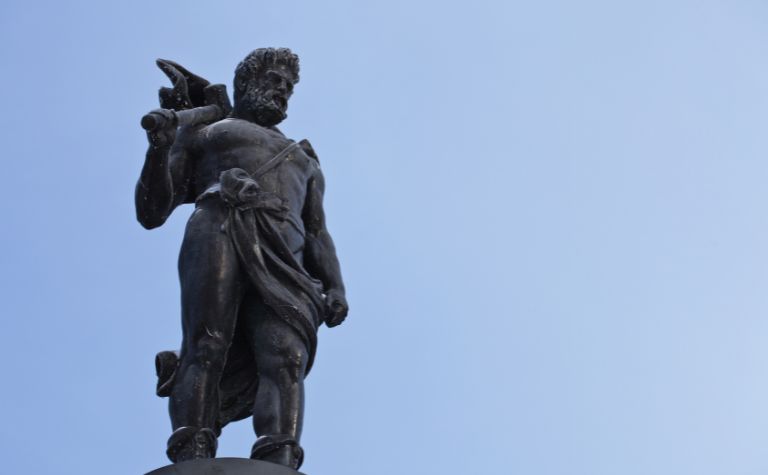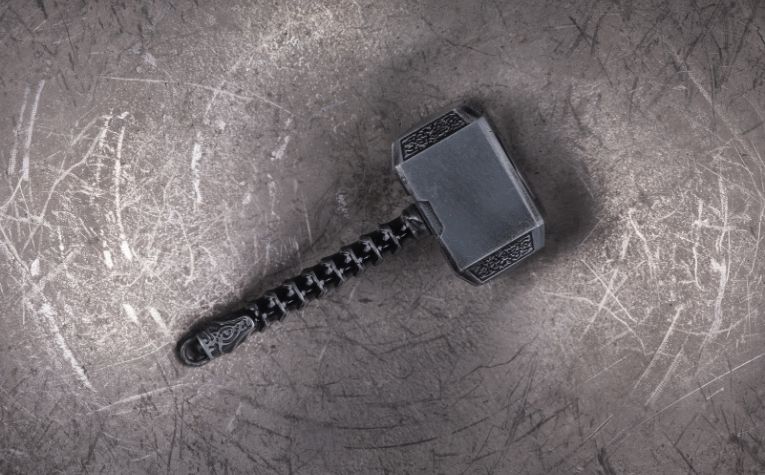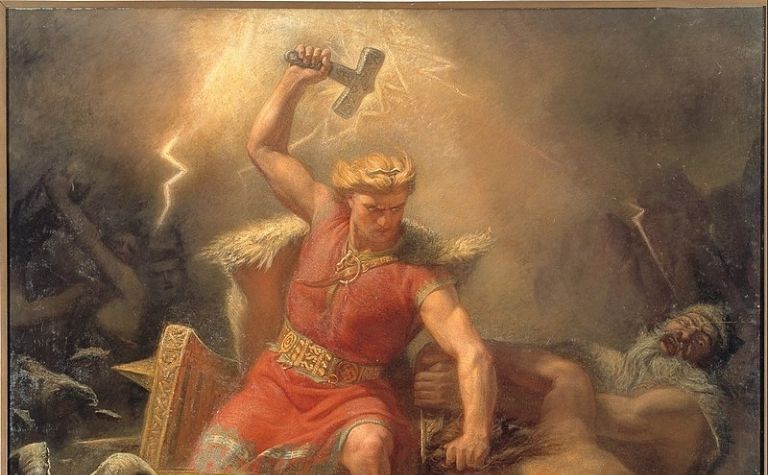“Thor is striking his anvil. He is angry with us. He wants to sink us.” This line was uttered by the character Rollo in the popular History Channel show Vikings.
The image of the mighty Thor hammering his anvil is a popular one, but was Thor actually a blacksmith?
Thor wasn’t a blacksmith. He was the god of thunder and the bearer of Mjolnir.
As a result, it’s common for casual fans of Norse mythology to attribute the sound of thunder to “Thor beating his anvil.”
A more in-depth reading of the myths will show that Thor never beat an anvil or worked a forge.
This article will explain why Thor was considered the god of thunder and why it has nothing to do with anvils or blacksmithing.
It will also discuss Mjolnir’s creation and whether the famous hammer was real. Finally, it will touch on the existence of blacksmiths during the Viking era.

Thor: the God of Thunder
Today, most people know Thor from Marvel movies, comics, or historical fiction movies and shows, like Vikings.
Unfortunately, while those sources do get some things right, they don’t get everything right.
That means modern-day Thor (and the things he does and says) are the only things most people remember.
So, if a character mentions Thor “striking his anvil,” viewers (or readers) assume he did just that, and that’s why he’s the god of thunder.
However, Thor was never a blacksmith, and the sound of thunder has never been associated with him working at his forge in any Norse myth.
Instead, there are two commonly stated associations between Thor and thunder.
The first is that Thor’s hammer, Mjolnir, makes a thunderous sound when he uses it to hit his enemies. [1]
The other explanation is the one most scholars and avid readers of Norse mythology accept.
Unlike in the Marvel movies, Thor from Norse mythology can’t fly using his hammer.
Instead, he has a chariot pulled by two flying goats, Tanngrisnir and Tanngnjóstr.
In this second explanation, the chariot is so large and powerful that humans can hear thunder whenever its wheels start moving across the ground. [2]
Either way, Thor is the thunder god, even if no one can agree on why.

Who Forged Mjolnir in Norse Mythology?
Thanks to pop culture, most people are familiar with Thor’s famous hammer, Mjolnir. Not everyone knows how he obtained it or who forged it, though.
In Norse mythology, the dwarven brothers Brokkr and Sindri (sometimes called Eitri) forged Mjolnir. Sindri actually created the hammer while Brokkr worked the bellows.
Though forged by dwarves, the hammer was created at the behest of Loki, who was trying to save himself from the wrath of Thor after he (Loki) cut off all of Thor’s wife’s beautiful golden hair. [3] (Some sources also say that Loki slept with Sif – Thor’s wife – before cutting off her hair.)
Whatever happened, Thor was murderously angry, and Loki knew the only way to appease him would be to bring him exceptional gifts.
First, Loki went to different dwarves, known only as the Sons of Ivaldi. From them, he commissioned three gifts to give to the gods. They were:
- Golden hair to replace Sif’s cut hair
- Odin’s spear, Gungnir
- Freyr’s ship, Skidbladnir
Then, Loki went to Brokkr and Sindri and asked for three more items. He goaded them into making gifts for the gods by telling them that he’d heard no dwarves could make finer goods than the Sons of Ivaldi.
Finally, Brokkr made a bet with Loki. If the things he and his brother made weren’t as good as the three gifts from the Sons of Ivaldi, Loki would win.
However, if their items were better, Brokkr would win and get to cut off Loki’s head. Then, the two brothers forged the following three things:
- Thor’s hammer, Mjolnir
- Odin’s magical golden armband, Draupnir
- Frey’s golden boar, Gullinbursti
In the end, Brokkr and Sindri won the bet, but a technicality allowed Loki to keep his head. Brokkr did get to sew his lips shut, which was a small consolation. [4]

Was Thor’s Hammer Real?
The answer will depend on who is being asked. Centuries ago, many people believed Thor and his hammer were real.
Today, only a handful of people still believe in and worship the Norse gods, mainly in the Scandinavian countries.
Most people agree that Thor’s hammer wasn’t real. Instead, it was an integral part of a mythological story, just like Zeus’ lightning bolt, Hermes’ winged shoes, and Poseidon’s trident.
However, many people thought the hammer was real in the Viking era.
Even today, Mjolnir is real in one respect. Anyone can go out and buy a replica of the hammer.
They could also wear Mjolnir necklaces, get Mjolnir tattoos, and purchase Mjolnir toys for their kids and Mjolnir toolboxes [5] for themselves.
However, as a powerful item imbued with magic, no, Mjolnir is almost certainly not real.
Did the Vikings Have Blacksmiths?
The Vikings had blacksmiths. In fact, blacksmiths were some of the most esteemed and important people in Viking society.
They weren’t rulers or decision-makers like kings and jarls, but they did forge the weapons that Vikings took with them into battle.
Since Vikings were primarily warriors, it was crucial that they be well-armed.
Having a good blacksmith – and treating that blacksmith with respect so he wouldn’t purposefully turn out bad weapons – was imperative to the Viking way of life.
Blacksmiths weren’t just weapons makers, though. They also crafted and forged many of the items people used in their everyday lives.
These items included, but were not limited to, the following:
- Plow shears
- Spades
- Nails
- Common knives
- Scissors or snips
- Pots
- Buckles
- Utility axes
Smiths made helmets and shields, as well. If people needed it and it was made of iron, the chances are that a blacksmith made it.
Final Thoughts
Though blacksmiths were esteemed in Viking culture, Thor wasn’t among their ranks. He used his hammer for fighting, not forging.
References:
[1] Source
[2] Source
[3] Source
[4] Source
[5] Source
